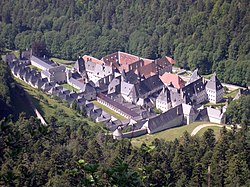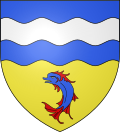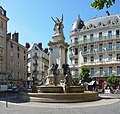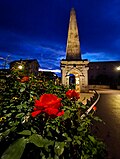Isère
 From Wikipedia - Reading time: 11 min
From Wikipedia - Reading time: 11 min
Isère
| |
|---|---|
 Location of Isère in France | |
| Coordinates: 45°20′N 05°30′E / 45.333°N 5.500°E | |
| Country | France |
| Region | Auvergne-Rhône-Alpes |
| Prefecture | Grenoble |
| Subprefectures | La Tour-du-Pin Vienne |
| Government | |
| • President of the Departmental Council | Jean-Pierre Barbier[1] (LR) |
| Area | |
• Total | 7,431 km2 (2,869 sq mi) |
| Elevation | 846 m (2,776 ft) |
| Highest elevation | 4,088 m (13,412 ft) |
| Lowest elevation | 134 m (440 ft) |
| Population (2022)[2] | |
• Total | 1,291,380 |
| • Rank | 15th |
| • Density | 170/km2 (450/sq mi) |
| Time zone | UTC+1 (CET) |
| • Summer (DST) | UTC+2 (CEST) |
| Department number | 38 |
| Arrondissements | 3 |
| Cantons | 29 |
| Communes | 512 |
| ^1 French Land Register data, which exclude estuaries and lakes, ponds and glaciers larger than 1 km2 | |
Isère (US: /iːˈzɛər/ ee-ZAIR,[3][4] French: [izɛʁ] ⓘ; Arpitan: Isera; Occitan: Isèra, Occitan pronunciation: [iˈsɛɾa]) is a landlocked department in the southeastern French region of Auvergne-Rhône-Alpes. Named after the river Isère, it had a population of 1,271,166 in 2019.[5] Its prefecture is Grenoble. It borders Rhône to the northwest, Ain to the north, Savoie to the east, Hautes-Alpes to the south, Drôme and Ardèche to the southwest and Loire to the west.
History
[edit]Isère is one of the original 83 departments created during the French Revolution on 4 March 1790. It was established from the main part of the former province of Dauphiné.[6] Its area was reduced twice, in 1852 and again in 1967, on both occasions losing territory to the department of Rhône.

In 1852 in response to rapid urban development around the edge of Lyon, the (hitherto Isère) communes of Bron, Vaulx-en-Velin, Vénissieux and Villeurbanne were transferred to Rhône.[7] In 1967 the redrawing of local government borders led to the creation of the Urban Community of Lyon (more recently known simply as Greater Lyon or Grand Lyon). At that time intercommunal groupings of this nature were not permitted to straddle departmental frontiers, and accordingly 23 more Isère communes (along with six communes from Ain) found themselves transferred to Rhône. The affected Isère communes were Chaponnay, Chassieu, Communay, Corbas, Décines-Charpieu, Feyzin, Genas, Jonage, Jons, Marennes, Meyzieu, Mions, Pusignan, Saint-Bonnet-de-Mure, Saint-Laurent-de-Mure, Saint-Pierre-de-Chandieu, Saint-Priest, Saint-Symphorien-d'Ozon, Sérézin-du-Rhône, Simandres, Solaize, Ternay and Toussieu.[8]
Most recently, on 1 April 1971, Colombier-Saugnieu was transferred to Rhône. Banners appeared in the commune's three little villages at the time proclaiming Dauphinois toujours ("Always Dauphinois").
Geography
[edit]Isère includes a part of the French Alps. The highest point in the department is the subpeak Pic Lory at 4,088 metres (13,412 feet), subsidiary to the 4,102 metres (13,458 feet) Barre des Écrins in the adjoining Hautes-Alpes department. The summit of La Meije at 3,988 metres (13,084 feet) is also well known. The Vercors Plateau aesthetically dominates the western part of the department.
Principal towns
[edit]The most populous commune is Grenoble, the prefecture. As of 2019, there are 7 communes with more than 20,000 inhabitants:[5]
| Commune | Population (2019) |
|---|---|
| Grenoble | 158,198 |
| Saint-Martin-d'Hères | 37,935 |
| Échirolles | 36,932 |
| Vienne | 29,993 |
| Bourgoin-Jallieu | 28,834 |
| Fontaine | 23,211 |
| Voiron | 20,372 |
Demographics
[edit]Inhabitants of the department are called Isérois (masculine) and Iséroises (feminine).
Population development since 1801:
|
| |||||||||||||||||||||||||||||||||||||||||||||||||||||||||||||||||||||||||||||||||
| ||||||||||||||||||||||||||||||||||||||||||||||||||||||||||||||||||||||||||||||||||
| source:[9][10] | ||||||||||||||||||||||||||||||||||||||||||||||||||||||||||||||||||||||||||||||||||
Politics
[edit]Departmental politics
[edit]The President of the Departmental Council has been Jean-Pierre Barbier of The Republicans (LR) since 2015.
Following the 2021 departmental election, the Departmental Council of Isère (58 seats) was composed as follows:
| Group | Seats | |
|---|---|---|
| • | The Republicans and allies | 26 |
| Socialist Party and allies | 13 | |
| • | Union of Democrats and Independents and allies | 5 |
| French Communist Party and allies | 5 | |
| Europe Ecology – The Greens and allies | 4 | |
| • | Independents | 3 |
| • | La République En Marche! | 2 |
Representation in Paris
[edit]National Assembly
[edit]In the 2022 legislative election, Isère elected the following representatives to the National Assembly:
In 2024, all the Renaissance and Democratic Movement candidates lost their seats: to La France Insoumise in the 1st and 9th constituencies, and to RN-coalition parties in the 8th and 10th. The other representatives were all reelected.[12]
Senate
[edit]In the 2017 Senate election, Isère elected Didier Rambaud (La République En Marche!), Guillaume Gontard (miscellaneous left), Frédérique Puissat (The Republicans), Michel Savin (The Republicans) and André Vallini (Socialist Party) for the 2017–2023 term.
Culture
[edit]
The Grande Chartreuse is the mother abbey of the Carthusian order. It is located 22 km (14 mi) north of Grenoble.
As early as the 13th century, residents of the north and central parts of Isère spoke a dialect of the Franco-Provençal language called Dauphinois, while those in the Southern parts spoke the Vivaro-Alpine dialect of Occitan. Both continued to be spoken in rural areas of Isère into the 20th century.
Tourism
[edit]Isère features many ski resorts, including the Alpe d'Huez, Les Deux Alpes, the 1968 Winter Olympics resorts of Chamrousse, Villard de Lans, Autrans. Other popular resorts include Les 7 Laux, Méaudre, Saint-Pierre-de-Chartreuse, Alpe du Grand Serre and Gresse-en-Vercors. At the department level, Isère is the third-largest ski and winter destination in France, after Savoie and Haute-Savoie. It also hosts Coupe Icare, an annual festival of free flight, such as paragliding and hang-gliding, held at the world-renowned paragliding site at Lumbin.
Grenoble has a dozen museums, including its most famous, established in 1798, the Museum of Grenoble. The European Synchrotron Radiation Facility (ESRF), an international research facility in Grenoble, is also open to visitors.
-
Ski lift at Alpe d'Huez
-
The Grand Veymont
-
The Dent de Crolles
-
Queyras Valley
-
Roman stela nicknamed "the pyramid", Vienne
-
Temple of Augustus and Livia, Vienne
See also
[edit]- Cantons of the Isère department
- Charmant Som
- Communes of the Isère department
- Arrondissements of the Isère department
- Chartreuse Mountains
- Grande Sure
- Isère departmental council
References
[edit]- ^ "Répertoire national des élus: les conseillers départementaux". data.gouv.fr, Plateforme ouverte des données publiques françaises (in French). 4 May 2022.
- ^ "Populations de référence 2022" (in French). The National Institute of Statistics and Economic Studies. 19 December 2024.
- ^ "Isère". The American Heritage Dictionary of the English Language (5th ed.). HarperCollins. Retrieved 22 August 2019.
- ^ "Isère". Merriam-Webster.com Dictionary. Merriam-Webster. Retrieved 22 August 2019.
- ^ a b Populations légales 2019: 38 Isère, INSEE
- ^ Frederick Converse Beach; George Edwin Rines (1912). The Americana: a universal reference library, comprising the arts and sciences, literature, history, biography, geography, commerce, etc., of the world. Scientific American compiling department. p. 741.
- ^ Revue du Lyonnais (in French). L. Boitel. 1865. p. 197.
- ^ Loi n°67-1205 du 29 décembre 1967 modifiant les limites des départements de l'Ain, de l'Isère et du Rhône, Journal officiel de la République française n° 0303, 30 December 1967, p. 12980.
- ^ "Historique de l'Isère". Le SPLAF.
- ^ "Évolution et structure de la population en 2016". INSEE.
- ^ Nationale, Assemblée. "Assemblée nationale ~ Les députés, le vote de la loi, le Parlement français". Assemblée nationale.
- ^ Desmas, Margot (7 July 2024). "Résultats définitifs des législatives 2024 en Isère : Olivier Véran battu à Grenoble, découvrez le député élu dans votre circonscription". France 3 (in French).
External links
[edit]- Prefecture website (in French)
- Departmental Council website (in French)
- Coolidge, William Augustus Brevoort (1911). . Encyclopædia Britannica. Vol. 14 (11th ed.). p. 867.
 KSF
KSF













